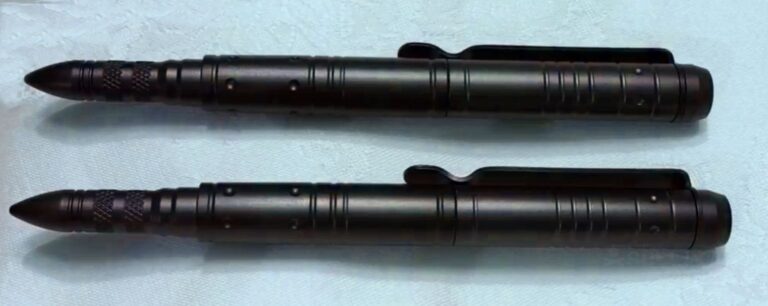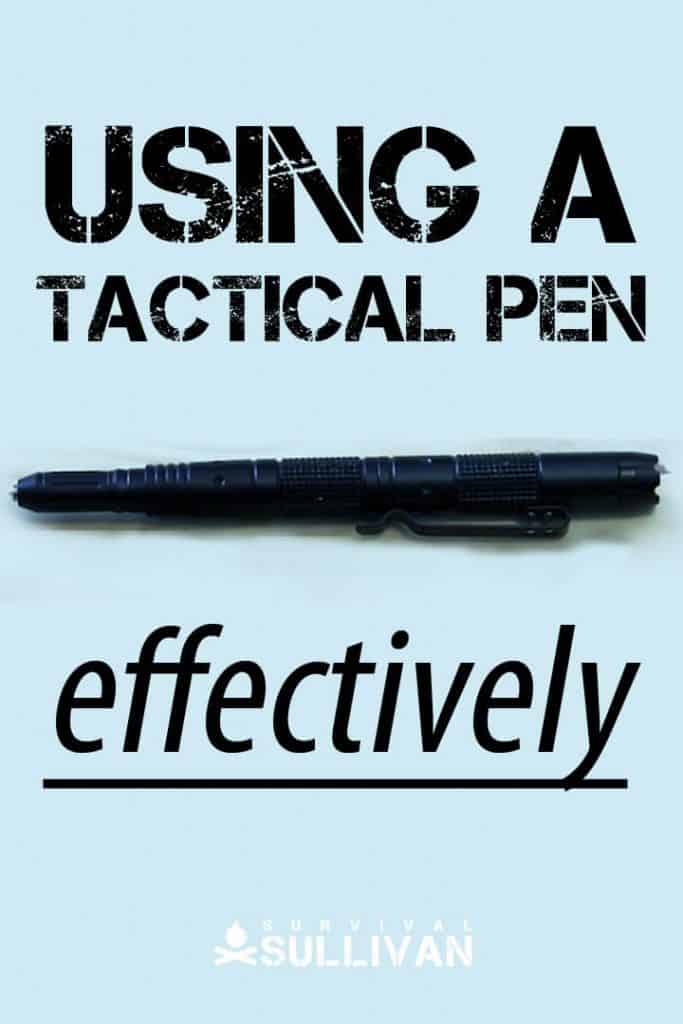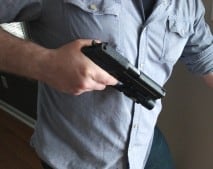Tactical pens are a niche but effective self-defense tool with one major advantage over all other weapons: they can go, quite literally, anywhere. This one attribute makes tactical pens a worthwhile addition to any prepper’s tactical options but using one requires its own skillset.

Sure, you can grab hold of the pen in your clenched fist and wail away on your assailant, but you should not expect great results.
Even a beefy pen made from hardened aluminum alloy or steel is still a small weapon and must be wielded with skill and diligence to inflict maximum damage. Learning how to properly employ your tactical pen will also help prevent injury when you repeatedly strike your foe.
In this article, we’ll be examining in detail the best techniques for self-defense with a tactical pen.
Table of Contents
Understanding the Pros and Cons of Tactical Pens
Before you can begin to learn techniques, you must understand what your weapon is and is not capable of. You will work to maximize what it is good at while shoring up its weaknesses.
As mentioned in the opening, your tactical pen has one huge advantage in that it can go anywhere and will, so long as its design is not overtly aggressive, pass through almost any security screening. It is just a pen, after all, just one made to be extremely durable.
This non-weapon status is equally invaluable when travelling into areas with highly restrictive gun and knife laws, or flying commercial where you cannot even have a nail file.
On defense, a tactical pen is a way to focus the power of a strike into a tiny surface area on the attacker’s body and also afford your hand a degree of protection compared to a punch.
Broadly considered, applying a tactical pen to someone is not considered lethal force, generally being lumped into the same category as kubotans, yawara sticks and other blunt or semi-blunt impact tools. The biggest edge a tactical pen can confer to you (aside from the go-anywhere nature of the thing) is its surprise factor.
A tactical pen is easy to carry, easy to hide and fast to deploy, meaning you can launch a powerful and painful, even debilitating first attack from seemingly nowhere when your attacker expects you, the would-be victim, to be unarmed.
If you strike with precision, the pain your attacker will feel resulting from a hardened piece of metal being driven furiously into his bones, muscles or joints will be shocking.
Suddenly, the tables have turned! He is now reacting to you, not the other way round, and you can close the fight or escape when you have an opportunity.
Tactical pens are not the best weapon for self-defense and not the solution for all problems. Their range is abysmal, and they do rely on a certain amount of skill to get the most from them, but their advantages allow them to go places at the ready that other weapons just cannot.
In the next section, we are going to drive right into the meat of the matter and discuss the proper way to hold your tactical pen and then strike your attacker with it.
Gripping the Tactical Pen
There is no great and mysterious technique for properly gripping the tactical pen. The two most common methods are the reverse, or ice-pick, grip and the forward grip, sometimes called the saber grip, a term borrowed from knife usage.
Of the two, the reverse grip is the most commonly employed since it lends itself best to a fast draw no matter how the pen is carried.
To employ the reverse grip, the pen is grasped in the middle of the fist with the point protruding beneath. The top of the pen should protrude at least an inch above the top of the fingers.
The thumb is curled over the top cap of the pen to reinforce the grip and keep the pen steady when driving it into the face, neck or skull.
Do take care to avoid tactical pens with sharply crenellated or spiked tops for this reason; it will injure you upon impact if held in this way. One striking surface is plenty on a tactical pen.
The reverse grip is the go-to grip with a tactical pen since you will be able to generate massive power with downward blows, just like you would with a hammerfist technique. Backhanded jabs, counters and strikes of opportunity are all possible using the reverse grip.
To employ the forward grip, you will do the same thing with two changes: the point of the pen is held upward, past the index finger and the thumb is wrapped around the fingers as with a normal fist.
The forward grip allows you to employ thrusts and other techniques similar to what you would use with a knife, or even some boxing punches, but is not as powerful typically as strikes delivered with the reverse grip.
No matter which grip you prefer or are forced to employ, grip the pen tightly! Very tightly! Even these slightly oversized and knurled, stippled pens are small diameter, and allowing it to shift in your hand when you deliver your blow will rob the strike of power.
A tight grip (especially with your thumb curled over the top) will increase the effectiveness quite a bit. Take care when buying a tactical pen that it fits your hand well and affords you a good grip.
Targeting with the Tactical Pen
Targets for the tactical pen are plentiful, but since it is not an incisive weapon, like a knife, or a heavy blunt weapon, like a club or crowbar accuracy is important.
No matter where you manage to hit, it will certainly hurt, but hurting is not enough; we must inflict injury to reduce our opponent’s capability and will to fight. If we pop him with a tactical pen hard one good time and he quits, so much the better, but we cannot count on that outcome.
The following target locations are presented with commentary geared toward situational selection and achieving best effect.
- Face
- Neck
- Collarbone
- Deltoid
- Hand
Learn more about these 5 areas to hit here.
NOTE: Strikes to the head and neck with a tactical pen may be considered lethal force depending on the amount of damage inflicted. Strikes to the throat and eyes will certainly be considered lethal force. Keep this in mind and only use the level of force that the situation calls for.
Tactical Pen Techniques
The following techniques all assume the pen is held in your dominant hand in a reverse (tip down) grip unless indicated.
The correct stance for use with the tactical pen is very akin to a boxing stance: feet shoulder width apart, toes pointing in same direction, strongside leg tailing slightly to the rear.
Stay relaxed and slightly loose and keep your weight centered on the balls of your feet for best mobility.
Now keep your chin down, and hands up around eye level, ready to defend, attack and counter. Your elbows should remain close to your sides, both for protection against blows but also to facilitate striking.
Palm to Face and Strike
This is a superb basic combination using the tactical pen against an unarmed assailant. Before the bad guy can throw a punch at you, snap your non-dominant hand out in a palm strike, not a punch, aimed at his chin. Aim behind him so you snap his head away from you and then drive in behind your “jab”.
This does two things: it will disrupt any punch he was going to fire and keep him from seeing your follow-on attack which is a big overhand strike to the side of his head or neck using your pen. Really give this shot the steam and the fight will be over before he realizes he lost.
From here, you can simply repeat the combination as you would a jab-cross or jab-overhand in boxing, using the reciprocating motion of each hand to set up the next blow. This is a bread and butter technique with the tactical pen.
Parry and Strike
This is a riff on the above technique, but one you can use against an attacker swinging a longer weapon as well as against a punch. As they swing at you, step to the outside and parry the attack with your non-dominant arm.
Follow-up on the parry and wrap up the attacking arm, halting their offensive. Before they can recover, fire off a wicked thrust into his face.
If he doubles over, maintain control of the attacking arm and then start raining overhand blows on the back of his head and neck, if that level of force is warranted, or on his shoulder and deltoid area if it is not.
If you ever get caught out before you can set up the type of blow necessary to bring the point of your pen to bear, remember that your tactical pen is in essence a fist load, and you can snap off a punch as you would any other time. Don’t miss an opportunity to do some damage just because it didn’t fit the script in your head.
Sternum Shot
If your space is being invaded and you have the pen in hand, you can back someone off of you really quick by powering the point of the pen into their sternum or solar plexus area with assistance. By assistance I mean backing up the strike with your non-dominant hand.
You want this to be a strike, piling on all the force at once, not something where you make contact and then gradually step up the pressure.
To execute, simply bring the hands together quickly with the non-dominant hand palm stacked over the base of the dominant hand thumb and wrist.
Then drive the point home viciously into the attacker’s chest. This should be executed as quickly as possible and a defensive hands-up posture reassumed as quickly as possible.
This will easily knock the wind out of someone’s sails and buy ample opportunity for you to disengage I they were not expecting it.
Uppercut
A particularly vicious shot executed with the pen held in the forward grip. This can also be executed with the reverse grip if your pen is long enough to protrude significantly from the top of your hand when held this way. If using the reverse grip, the thumb is removed from the cap and wrapped around the hand normally.
To set up this strike, go for it on the backside of a parry or any time you are in very close. Simply wind up and drive the point of the pen into the soft underside of the jaw. This is exquisitely painful, and can easily puncture and ravage the soft tissues of the mandible and mouth.
Another variant is a straight in shot if you use a punch or palm strike to snap and hold the attacker’s head back, exposing the jaw to harm.
Low Level Shots
You may, as many fights do, end up tussling on the ground with your attacker before it is over. If this is the case, you will likely have better opportunities for low level targets. The large muscle groups of the thigh are excellent candidates for overhand blows when the pen is held in the reverse grip as is the hip junction.
If you are able to gain top positioning or even begin to gain your feet, a shot to the side of the knee is very damaging and great way to ensure escape. The ankle is another “mobility crippling” target that can prevent pursuit when broken.
One particularly hideous blow worth mentioning is the groin shot. Always agonizing for men and women alike when struck with any kind of force, to say nothing of a full power blow, you can take it to the next level by doing the same with a tactical pen.
Anything worth hitting with a fist is doubly worth hitting with a tactical pen!
Hook and Trap
A tactical pen is a shoe-in for a kubotan or mini-baton for trapping and controlling an offender’s limb. Held in the reverse grip, the length of the pen can wrap around and grant leverage over anything from a wrist to an elbow, and even be used up near the shoulder to help you turn or spin an opponent.
A variety of small joint locks are made better and more secure by applying them in conjunction with a tactical pen.
Pressure point compliance techniques are also made easy with a tactical pen, giving you expanded force options when mauling someone with the pointy end is not appropriate.
A dissertation covering those maneuvers and their variations is beyond the scope of this article, but you should seek out that info to round out your tactical pen skill set.
Ready for Some Practice?
The tactical pen is a versatile, concealable and constant companion thanks to its unassuming appearance. Easy to hide and easy to draw, a tactical pen is the perfect low profile tool to turn the tide in a hands-on fight when others are unavailable or expressly forbidden.
Maximizing the tactical pen is highly dependent on good technique, and by taking the time to master some of the moves presented above you’ll be well on your way to hitting way above your pen’s weight class.


Charles Yor is an advocate of low-profile preparation, readiness as a virtue and avoiding trouble before it starts. He has enjoyed a long career in personal security implementation throughout the lower 48 of the United States.

The problem with all short weapons is you need to be close to use them.
And if you are close enough to strike someone, they are close enough to strike you.
While the law abiding, or law conscious, would welcome the covert capabilities of a tactical pen, generally your attacker isn’t a professional, won’t worry about quaint little laws, and isn’t there just to disable you.
Add alcohol and rage and all restraint goes, and drugs can render the attacker non sensitive to pain.
That sort of attack is fast, furious, and won’t stop just because you fall and a kicking usually follows you going down. That’s the reality I know.
I’m lucky (sort of). I have to use walking sticks as a mobility aid.
Whilst that may single me out as an easy target, the truth is way different.
Having attended tactical training with a baton, the conversion to using a 30 inch heavy wooden walking stick as a defensive weapon was easy. To back that up I also attended a course specifically for the use of a walking stick for self defense (and no it wasn’t a martial arts course, it was a street survival course) and practice A LOT.
It paid off too, I was the subject of a mugging a few years ago and the end score was two-nil to me.
One left with a shattered knee, the other would have been seeing stars for quite a while.
One was armed with a blade, but BOTH never got within arms reach of me.
For me, distance is king in combat.
If they cannot reach you, they cannot hurt you.
It’s great that you carry a walking stick. Some carry a gun (including me when I can) some have a body guard. But the reality is you often don’t have the option to carry a stick, gun or body guard. The tactical pen is something you can always have on you. It is for close combat and they work with a jab to the ribs to get the attacker off of you so you can escape. It is a weapon for when there are no other options. Yes your walking stick, a gun or a Delta force team would be preferred but this is a discrete option for everyday carry. For this it serves its purpose. Congrats on serving justice to your attackers!